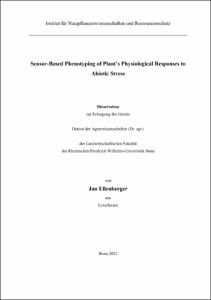Ellenberger, Jan: Sensor-Based Phenotyping of Plant’s Physiological Responses to Abiotic Stress. - Bonn, 2022. - Dissertation, Rheinische Friedrich-Wilhelms-Universität Bonn.
Online-Ausgabe in bonndoc: https://nbn-resolving.org/urn:nbn:de:hbz:5-64963
Online-Ausgabe in bonndoc: https://nbn-resolving.org/urn:nbn:de:hbz:5-64963
@phdthesis{handle:20.500.11811/9594,
urn: https://nbn-resolving.org/urn:nbn:de:hbz:5-64963,
author = {{Jan Ellenberger}},
title = {Sensor-Based Phenotyping of Plant’s Physiological Responses to Abiotic Stress},
school = {Rheinische Friedrich-Wilhelms-Universität Bonn},
year = 2022,
month = feb,
note = {Plant phenotyping can be defined as the systematic recording of morphological, anatomical, physiological and chemical characteristics of plants, as well as their developments and responses to stimuli. The common use of sensors in crop phenotyping today has stretched the limits of what can be recorded as a phenotype:
Firstly, because sensors expand the perceptual horizons of human senses, and computer-assisted acquisition, storage and analysis of large amounts of data provides insights that would not be possible through purely human observation. Secondly, measurement standardized through sensor use potentially enables better comparability of phenotyping activities performed at different locations by different work-groups.
This thesis focuses on three challenges of modern sensor-based phenotyping of plants under abiotic stress:
1. The chapter "Phenotyping in Arabidopsis and Crops – Are We Addressing the Same Traits? A Case Study in Tomato" addresses the challenges that arise from comparing phenotypes of different plant species. Using Arabidopsis thaliana and tomato under drought stress as examples, causes of lack in comparability of phenotyping data generated by scientists from different disciplines with different goals and perspectives on plants are discussed. In addition, ways toward overcoming this problem are presented.
2. In the chapter "Factors Influencing Chlorophyll Meter Readings – Toward a Conceptual Framework", the influence of confounding variables on phenotypic measurements is analyzed using non-invasive chlorophyll measurements as an example. The chapter provides an overview of the functioning of noninvasive chlorophyll meters. In addition, a possible way to deal with confounding variables, namely explicit inclusion in the statistical model, is presented.
3. Finally, in the chapter "Effect of UV Radiation and Salt Stress on the Accumulation of Economically Relevant Secondary Metabolites in Bell Pepper Plants," the potential of sensor-based phenotyping to quantify economically relevant secondary metabolites in bell bell pepper leaves is discussed. The physiological basis of non-invasive detection is also explained.
The present work may be helpful to scientists in the field of phenotyping primarily in that it may provide new perspectives on phenotyping as a whole. Advanced phenotyping may in turn help both plant breeders and farmers and the society as a whole.},
url = {https://hdl.handle.net/20.500.11811/9594}
}
urn: https://nbn-resolving.org/urn:nbn:de:hbz:5-64963,
author = {{Jan Ellenberger}},
title = {Sensor-Based Phenotyping of Plant’s Physiological Responses to Abiotic Stress},
school = {Rheinische Friedrich-Wilhelms-Universität Bonn},
year = 2022,
month = feb,
note = {Plant phenotyping can be defined as the systematic recording of morphological, anatomical, physiological and chemical characteristics of plants, as well as their developments and responses to stimuli. The common use of sensors in crop phenotyping today has stretched the limits of what can be recorded as a phenotype:
Firstly, because sensors expand the perceptual horizons of human senses, and computer-assisted acquisition, storage and analysis of large amounts of data provides insights that would not be possible through purely human observation. Secondly, measurement standardized through sensor use potentially enables better comparability of phenotyping activities performed at different locations by different work-groups.
This thesis focuses on three challenges of modern sensor-based phenotyping of plants under abiotic stress:
1. The chapter "Phenotyping in Arabidopsis and Crops – Are We Addressing the Same Traits? A Case Study in Tomato" addresses the challenges that arise from comparing phenotypes of different plant species. Using Arabidopsis thaliana and tomato under drought stress as examples, causes of lack in comparability of phenotyping data generated by scientists from different disciplines with different goals and perspectives on plants are discussed. In addition, ways toward overcoming this problem are presented.
2. In the chapter "Factors Influencing Chlorophyll Meter Readings – Toward a Conceptual Framework", the influence of confounding variables on phenotypic measurements is analyzed using non-invasive chlorophyll measurements as an example. The chapter provides an overview of the functioning of noninvasive chlorophyll meters. In addition, a possible way to deal with confounding variables, namely explicit inclusion in the statistical model, is presented.
3. Finally, in the chapter "Effect of UV Radiation and Salt Stress on the Accumulation of Economically Relevant Secondary Metabolites in Bell Pepper Plants," the potential of sensor-based phenotyping to quantify economically relevant secondary metabolites in bell bell pepper leaves is discussed. The physiological basis of non-invasive detection is also explained.
The present work may be helpful to scientists in the field of phenotyping primarily in that it may provide new perspectives on phenotyping as a whole. Advanced phenotyping may in turn help both plant breeders and farmers and the society as a whole.},
url = {https://hdl.handle.net/20.500.11811/9594}
}






